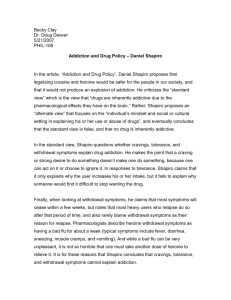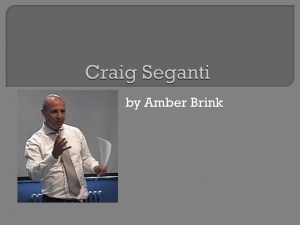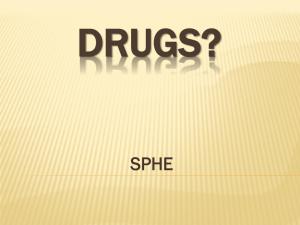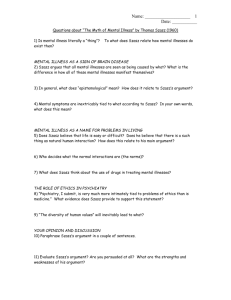DrugLegalization.doc
advertisement
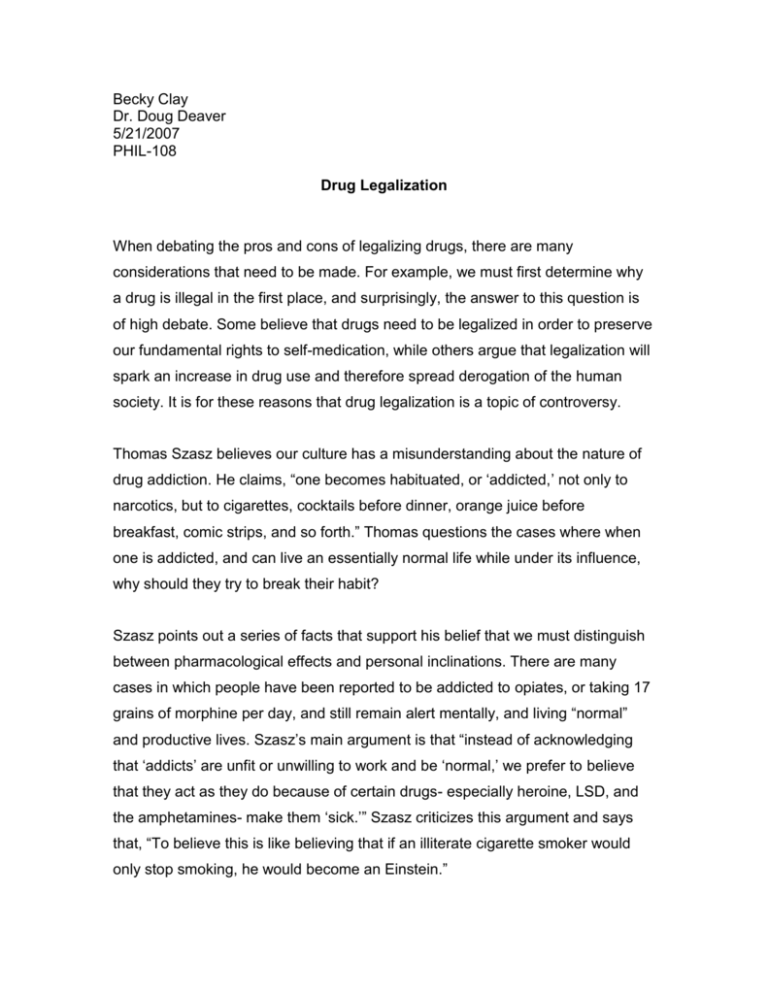
Becky Clay Dr. Doug Deaver 5/21/2007 PHIL-108 Drug Legalization When debating the pros and cons of legalizing drugs, there are many considerations that need to be made. For example, we must first determine why a drug is illegal in the first place, and surprisingly, the answer to this question is of high debate. Some believe that drugs need to be legalized in order to preserve our fundamental rights to self-medication, while others argue that legalization will spark an increase in drug use and therefore spread derogation of the human society. It is for these reasons that drug legalization is a topic of controversy. Thomas Szasz believes our culture has a misunderstanding about the nature of drug addiction. He claims, “one becomes habituated, or ‘addicted,’ not only to narcotics, but to cigarettes, cocktails before dinner, orange juice before breakfast, comic strips, and so forth.” Thomas questions the cases where when one is addicted, and can live an essentially normal life while under its influence, why should they try to break their habit? Szasz points out a series of facts that support his belief that we must distinguish between pharmacological effects and personal inclinations. There are many cases in which people have been reported to be addicted to opiates, or taking 17 grains of morphine per day, and still remain alert mentally, and living “normal” and productive lives. Szasz’s main argument is that “instead of acknowledging that ‘addicts’ are unfit or unwilling to work and be ‘normal,’ we prefer to believe that they act as they do because of certain drugs- especially heroine, LSD, and the amphetamines- make them ‘sick.’” Szasz criticizes this argument and says that, “To believe this is like believing that if an illiterate cigarette smoker would only stop smoking, he would become an Einstein.” The suggestion Szasz proposes is to respect our fundamental rights to selfmedication, just as we do towards our freedom of speech and religion. Like most rights, Szasz believes that the right to self-medication should only apply to adults, and it should not be an unqualified right. He raises the question, “How long can we live with the inconsistency of being expected to be responsible for operating cars and computers, but not for operating our own bodies?” Ethan Nadelmann argues that the real harm is from drug legislation. He believes that current drug laws are responsible for much of what Americans identify as a drug problem. If the production and sale of drugs were subject to government regulation, much physical harm that users suffer from could be avoided. While Nadelmann grants that the strongest moral justification for treating the currently illicit rugs is a paternalistic one, but notes that such laws are far outweighed by the harms resulting from the laws themselves. Nadelmann considers the potential consequences of criminalizing the production, sale and possession of tobacco products. On the positive side, the number of smokers would most likely decline, as well as the health costs associated with tobacco consumption. On the negative side, millions of Americans (both tobacco addicts and regular users) would defy the law only generating a massive underground market earning billions for organized criminals. Nadelmann compares the current use of illicit drugs to the time of Prohibition, reminding us, “laws and policemen were unable to eliminate the smugglers, bootleggers, and illicit producers, as long as tens of millions of Americans continued to want to buy alcohol.” By repealing the drug-prohibition laws, Nadelmann believes, promises tremendous advantages, He predicts there will be reduced government expenditures on enforcing drug laws and new tax revenue from legal drug production and sales. He also acknowledges that legalization is a risky policy, since it may lead to an increase in drug abusers. At the same time, Nadelmann points out that the current drug-control policies are failing, and that until we are willing to honestly evaluate our opinions on the matter, we may never find the solution for our drug problems. While Nadermann stresses the benefits of legalization, James Wilson stresses the benefits of the current system. He believes that drug legalization will result in “a sharp increase in drug use, a more widespread degradation of the human personality, and a greater rate of accidents and violence.” Wilson argues that there is far more benefits for keeping elicit drugs illegal. Wilson believes that “the dependency on certain mind-altering drugs is a moral issue and that their illegality rests in part on their immorality.” When comparing tobacco to cocaine, Wilson states that both are highly addictive, both have harmful effects, however while tobacco shortens one’s life, cocaine debases it. He goes on to say that the heavy use of crack “corrodes those natural sentiments of sympathy and duty that constitute our human nature and make possible our social life.” Wilson believes that successful treatment and education are only possible if drugs remain illegal. He supports this belief by saying that education programs that are aimed at dissuading children from doing something perfectly legal would be unsuccessful. Also, while Wilson acknowledges that some drug-dependent people genuinely want treatment, mot want only short-term help after a bad crash. He argues that addicts that enter treatment under legal compulsion stay in the program longer than those who are not under pressure. He adds that if compulsion is a useful component of treatment, it is not clear how it could be achieved in a society where purchasing, possessing, and using the drug were illegal. Daniel Shapiro proposes an argument that undercuts the worry that legalizing cocaine and heroine would produce an explosion of addiction. He criticizes the “standard view” which is the view that “drugs are inherently addictive due to the pharmacological effects they have on the brain.” Rather, Shapiro proposes an “alternate view” that focuses on the “individual’s mindset and social or cultural setting in explaining his or her use or abuse of drugs.” In the standard view, Shapiro questions whether cravings, tolerance, and withdrawal symptoms explain drug addiction. He makes the point that a craving or strong desire to do something doesn’t make one do something, because one can act on it or choose to ignore it. In responses to tolerance, Shapiro claims that it only explains why the user increases his or her intake, but it fails to explain why someone would find it difficult to stop wanting the drug. Finally, when looking at withdrawal symptoms, he claims that most will cease within a few weeks, however most heavy users who relapse do so after that period of time, and also rarely blame withdrawal symptoms as their reason for relapse. In his alternate view, Shapiro proposes that “how one interprets or understands the experience depends on one’s individuality and the cultural or social setting” and it is this process, which makes an addict, not the drugs themselves. He uses the example of hospital patients that get continuous and massive doses of narcotics, yet rarely get addicted or even crave these drugs after release from the hospital. In another example, Shapiro mentions, “three-quarters of Vietnam vets who used heroine in Vietnam became addicted, but after coming home, only half of the heroine users in Vietnam continued to use, and of those only 12 percent were addicts.” Because Shapiro feels he has proven that cocaine and heroine are not inherently addictive, he believes that the standard view is false, and that legalizing such drugs would not result in an explosion of addiction. He believes that “if cocaine and heroine in a legal market would be as disruptive as many drug prohibitionists fear, then that is an excellent reason why addiction would not explode under legalization- drug use that tends to thrive is drug use that is woven into, rather than disrupts, reasonable people’s lives…” It is hard to determine what the correct course of action is to take when debating the pros and cons of legalizing drugs, this most likely due to the fact that we cannot come to a conclusion as to what distinctly determines an “addict.” If an addict is, as Shapiro argues, a person who is not addicted to the pharmacology of a drug but rather the set and setting they experience from the drug, then clearly there should be no reason to restrict the distribution of such a drug. However, because these facts have not been proven, we are left to rely on our perceptions (false or not) that we have of addicts that are currently in our society.

